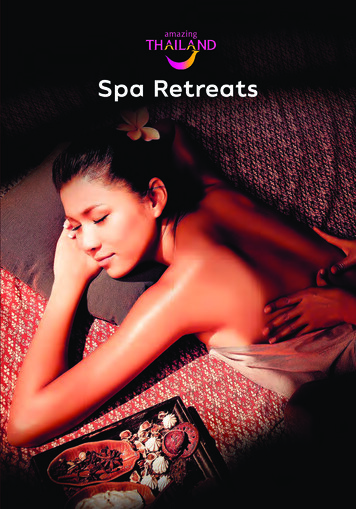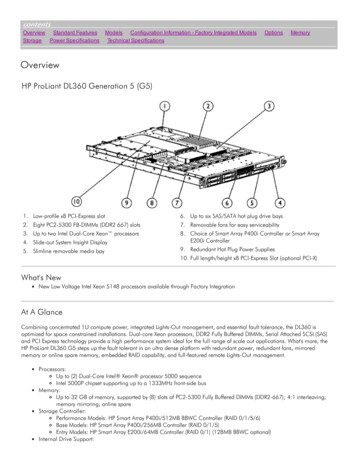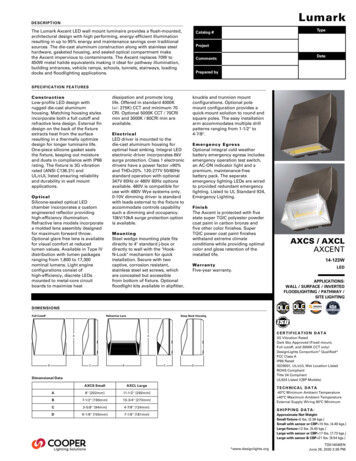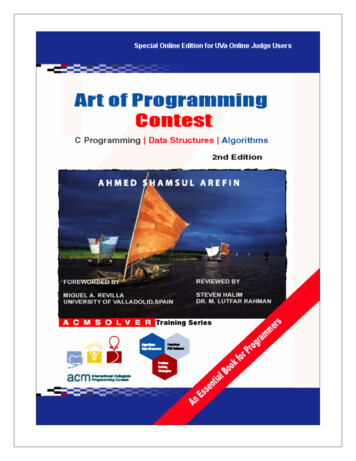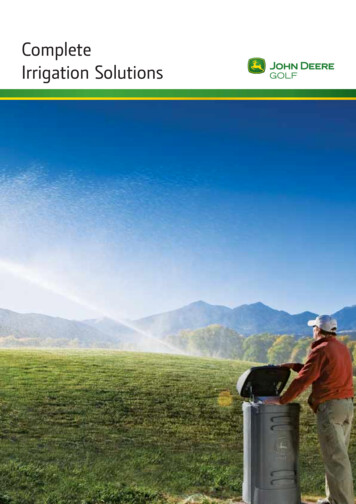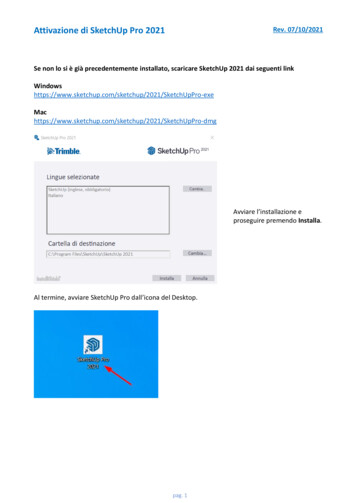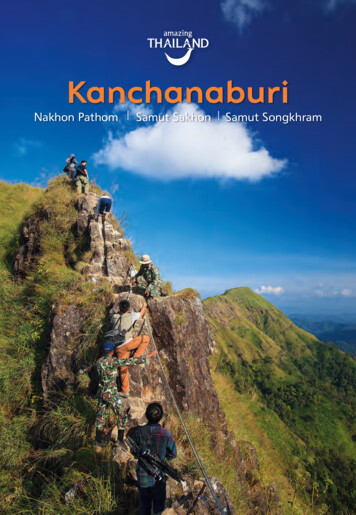
Transcription
KanchanaburiNakhon PathomSamut SakhonSamut Songkhram
Sangkhla Buri
CONTENTSKANCHANABURICity Attractions89Out-of-City Attractions11Special Events20Special Interest21How to Get There21NAKHON PATHOM22City Attractions23Out-of-City Attractions23Special Events27How to Get There27SAMUT SAKHON28City Attractions29Out-of-City Attractions29Shopping31Special Events31How to Get There31SAMUT SONGKHRAM32City Attractions33Out-of-City Attractions34Special Interest37Special Events37How to Get There37
KanchanaburiKanchanaburiNakhon PathomSamut Sakhon Samut Songkhram
Vajiralongkorn DamSrinagarindra DamKhuean Srinagarindra National Park
Mon BridgeKANCHANABURI
Located 130 kms. west of Bangkok, justa two-hour drive away, the small town ofKanchanaburi is the capital of Thailand’s thirdlargest province, which covers almost 20,000square kilometres and stretches as far west asthe border with Myanmar. The province boastssome of the country’s most beautiful waterfallsand caves in its national parks, as well as thehistoric bridge over the River Kwai and excitingactivities like rafting trips. Thus, it is an idealspot to explore the Thai countryside withouttravelling too far from Bangkok. Kanchanaburihas lots of character, and is a great place tostay in raft houses on the river. There are manyplaces worth visiting around town, but topof most people’s list are the bridge and thewar museums that chronicle the building ofthe infamous “Death Railway” across the RiverKwai and on Myanmar during World War II. Thehills and valleys are scattered with intriguingtemples and historical sites, and the lushwooded landscapes are ideal for cycling,trekking, raft trips or elephant rides.CITY ATTRACTIONSThe Bridge over the River KwaiSituated just to the north of the town, thisbridge was made famous by the 1957 film“Bridge over the River Kwai” by David Lean,though in fact the movie portrayed a woodenbridge that was constructed earlier. Bothbridges were badly damaged by Allied planeattacks in 1944 and 1945, but several archesof the metal bridge stood throughout and itwas repaired after the war. The bridge was thekey point in the so-called “Death Railway” thatconnected Thailand and Myanmar, intendedto provide a supply line for Japanese troops inMyanmar, though the work was completed onlyat the loss of countless lives of prisoners-of-warand local labourers supervised by Japanesetroops. The railway line was only used a fewtimes before the Japanese surrender, afterwhich the British tore up part of the track,making it inoperative. These days it ispossible to cross the bridge on foot or by trainon the way to the waterfall, about 100 kms.to the northwest. Steam train enthusiasts willbe delighted to see a few World War II eramachines displayed beside the bridge.Those with a particular interest in the history ofthe area should time their visit to coincide withthe River Kwai Bridge Festival, late Novembereach year.The Death RailwayThe Death Railway originally started atNong Pla Duk Station in Amphoe BanPong of Ratchaburi Province, passingKanchanaburi across the Kwai Yai Riverand the Three Pagodas Pass on the westto Tanbyuzayat in Myanmar. The historicrailway built at the cost of lives and labourruns through fabulous sceneries on bothsides, especially at Krasae Cave where thebreathtaking journey runs along the high cliffoverlooking the Kwai Noi River. The railwaypresently ends at Ban Tha Sao or Namtok(Waterfall) Station, a distance of about 77kilometres. The State Railway of Thailand(SRT) operates daily services on the route anda special Bangkok-Namtok trip on weekendsand public holidays. For more information,contact SRT at Tel. 66 2220 4334 and 66 26218701 or hotline 1690.JEATH War Museum“JEATH” refers to the six countries involved inthe building of the railway-Japan, England,Kanchanaburi9
The Bridge over the River KwaiKanchanaburi War CemeteryAmerica, Australia, Thailand and Holland andthis museum located to the south of the towncentre next to Wat Chaichumphon givesa vivid picture of the terrible conditions inwhich the Allied prisoners-of-war lived. Themuseum building is a copy of the long thatched bamboo huts that used to housethe prisoners during the war. On display arepaintings, photographs and newspaper articlesfrom the period, detailing the cruel torturemethods. The museum is open from 8.30 a.m.- 6.00 p.m.Kanchanaburi War CemeteryWorld War II MuseumLocated near the Kanchanaburi War Cemetery(Don Rak), it puts on an exhibition of history ofthe Thailand-Burma railway from the invasionof the Imperial Japanese Army, planning andconstruction of the railway, its geography, livingcondition in POW camps, medical aspects,summary of deaths, operation, bombingbombing and end of the railway, as well asaftermath of the way. Open daily during 9.00a.m.-5.00 p.m. For more information, pleasevisit www.tbrconline.comThis museum, located just south of the bridge,contains war memorabilia in the form of bombshells, photos and sketches from the period,statues of important war leaders, and over 100skeletons of Asian labourers found in a massgrave. In a separate building there are displaysof Buddha images, Thai weaponry from theAyutthaya period and portraits of the kingsof Thailand. The museum is open from 8.00a.m. - 6.00 p.m.10 KanchanaburiPerhaps even more moving than the bridge ormuseums are the lines of identical gravestonesin the cemetery located just near the trainstation. The remains of almost 7,000 Alliedprisoners are buried here; many of the memorialslabs are unidentified, but several give detailsof the soldiers, showing that the great majoritywere very young indeed. A memorial service isheld each year on Anzac Day, 25 April.Thailand-Burma Railway Centre
Wat Tham Mangkon ThongOUT-OF-CITY ATTRACTIONSThe main attraction of this temple, locatedabout 5 kms. east of the town centre, is the“Floating Nun”, a Buddhist nun who regularlymeditates while floating in a pond. The templeis located on a hillside, and there are caves abovethe temple that offer fine views of the area.Ban Nong KhaoBan Kao National Museum8 kilometres from Prasat Mueang Sing, and 35kilometres from town, this museum overlooksthe Kwai Noi River. The museum wasconstructed beside a Neolithic burial sitediscovered by an Allied prisoner-of-war duringthe construction of the Death Railway. About4,000 years ago. Neolithic man lived, roamedand hunted beside the Kwai Rivers, shelteringbeneath rock overhangs or in nearby caves.The Ban Kao Museum houses skeletal remains,pots, axe heads, jewellery made from animalbones, and other artefacts dating from that era.Pak Phraek RoadStraddling the Kwai Yai River, next to the citywall, Pak Phraek Road was the site of an ancientcommunity in Kanchanaburi. Its history datesback to the early days of Kanchanaburi itself.With its strategic location at the waterwaytransport junction, the area was an importanttrade hub of the city. It is presently a majorconnecting point of various destinations inKanchanaburi, including the old city wall andgate, the Shrine of the City Pillar and the WatTai War Museum. This road is also close tothe main river pier plied by tour boats and rafts.Tourists, however, prefer wandering throughold architectures of wooden houses andcommercial buildings lining more than 1kilometre of the road.Located at Tambon Nong Khao, about 12kilometres from the city on Highway No.324(Kanchanaburi-Suphan Buri), this village isfamous as the source of high-quality heirloomtextile, the multi-coloured “Phakhao Ma”(all-purpose cloth) in particular. Residents leadsimple lifestyle of a farm community, giving aunique experience to the visitors. Typical Thaihouses of the old days are generally seen, withancient practices and customs maintained;such as, paddy pounding in mortar, palmsugar and traditional Thai dessert making,tonsure ceremony for kids reaching puberty,manual rice planting, and the performance ofthe farmers’ songs.Erawan National ParkThailand has over 100 national parks, and oneof the most visited of them all is Erawan, 65kms. or an hour and a half drive northwestof Kanchanaburi. Flocks of visitors come tosee the seven-tiered waterfall that gives the550-square- kilometres park its name. Thetop level of the falls is thought to resemblea three-headed elephant, called “Erawan”in Thai, that is ridden by Indra in Hindumythology. With milky turquoise waterstumbling over various cascades, the falls arewonderfully photogenic and thought by manyto be Thailand’s most beautiful. Several of thepools below the falls are ideal for bathing in,especially level two, and they are much lesscrowded on weekdays. About 10 kms. beyondsthe park headquarters is Tham Phrathat, a largecave adorned with beautiful stalactites. Tel. 66 2562 0760-2Kanchanaburi11
Khuean Srinagarindra National ParkKhuean Srinagarindra National ParkNamtok Huai Mae KhaminLocated just north of Erawan National Park,this park covers over 1,500 square kilometres.Since it is more difficult to get to than Erawan,it is less frequently visited, but nonetheless hassome very special attractions, including NamtokHuai Mae Khamin, which also has seven levelsand is a close contender to Namtok Erawanfor sheer beauty. As at Erawan, the water isgenerally a lovely pale green, but here it runsover a caramel-coloured rockface, and thereis a superb viewing spot directly in front. Theeasiest way to get to the falls is by a two-hoursboat journey across the Srinagarindra Dam,a unique landscape of gesturing treetopsrising from mirror-like waters. Contact Tel. 66 2325 5498 or visit www.dnp.go.th for moreinformation.Located within the area of Srinagarindra Dam,about 10 kilometres from the city area, thiswondrous waterfall lies hidden in the pristineforest rich in flora. The waterfall originates fromthe watershed of Kala Mountain Range whichis a dry rainforest to the east of the NationalPark, flowing into the reservoir of SrinagarindraDam. It is regarded as one of the most beautifulwaterfalls ever found in the country. Thecascade is in 7 levels, each with its given name,as Dong Wan – the groove of herbs, ManKhamin – curtain of turmeric, Wang Na Pha – thepool over the cliff, Chat Kaeo – the umbrellaof glass, Lai Chon Long – the lost current,Dong Phisuea – the butterfly haunt, and RomKlao – under the aura. A trail has been markedby the National Park for visitors to trek to eachlevel through various surroundings in nature.The best period to visit the waterfall is fromOctober to April.12 Kanchanaburi
Namtok Huai Mae KhaminBo PhloiLocated 40 kms. north of Kanchanaburi, the smallvillage of Bo Phloi has a Jewellery HandicraftCentre, where blue sapphires mined locally arefashioned into beautiful rings and pendants.Safari Park Open Zoo & CampJust near Bo Phloi village, this safari park has adiverse collection of large African and Asianmammals; such as, lions, tigers, bears, giraffes andzebras. It is open from 9.00 a.m.- 6.00 p.m. ContactTel. 66 3467 8225, 66 8 6300 0667 or visitwww.safaripark-kan.com, safarivolunteer.comfor more information.Chaloem Rattanakosin National ParkThis tiny national park, situated just under100 kms. north of Kanchanaburi, covers just59 square kilometres, but has two large cavesand several waterfalls connected by a trail thatbegins at the visitor centre. Accommodation isavailable. Contact Tel. 66 2562 0760-2 or visitwww.dnp.go.th for more information.Wat Tham SueaLocated at Tambon Sing in Amphoe Saiyok,the forest temple was established in 1994under the auspices of the venerable LuangtaBua Yanasampanno, when villagers saved anorphaned tiger cub, a Pantheratigriscorbetti,and entrusted it to the temple. The abbotadopted the cub as his own offspring, withcompassion as the principle. The temple hasbecome a shelter for injured, orphaned andabandoned wild animals. This temple illustratesthat animals and humans coexist amicably.so that the Times Magazine of 22 May 2006cited the temple as the best example of apeaceful coexistence in the world. The latestfigures show that there are now 17 tigers,7 saved from the jungle, and 10 born at thetemple.Kanchanaburi13
Helfire Pass Memrial Musuem
Prasat Mueang Sing Historical ParkBuilt around the end of the 12th century, thisplace was once the westernmost outpost ofthe Khmer Empire, strategically located onthe banks of Kwai Noi River 43 kms. west ofKanchanaburi. The shrine complex at theheart of the site has been restored to givean idea of the structure’s original size,and a few remnants of the original stuccoornamentation can still be seen. It is openfrom 9.00 a.m. - 4.30 p.m. For more information,visit www.muangsinghp.com Tel. 66 34670264-5Rail Journey to the WaterfallOne of the best ways to see the countrysidearound town is to take the two-hours journeyby train from Kanchanaburi to the waterfallwhich operates three times a day. The trainstops regularly at attractive village stations,and the views from the left side are particularlyimpressive as the route passes through steepgorges and round sheer cliff faces. The mostpopular attraction is Namtok Sai Yok Noi, thewaterfall located a few kilometres north oftown, and boat operators also offer trips upand down the river before the train returns.Boat TripsAnother relaxing way to enjoy Kanchanaburi’ssurroundings is to take a raft trip, whichtypically includes several of the nearbyattractions, a leisurely lunch, and an overnightstay on the raft. For those with less timeto spare, long-tail boats can be hired tovisit a variety of riverside places. For moreinformation, contact any hotel, guesthouse,or the TAT office in Kanchanaburi. Tel. 66 34511200.Thung Yai Naresuan and Huai KhaKhaeng Wildlife SanctuaryThung Yai Naresuan and Huai Kha KhaengWildlife Sanctuaries are jointly inscribed asThailand’s UNESCO Natural World Heritage Sitein 1991. Abundant with wild animals, florasand faunas, they are the largest protectedland of the kingdom. Here visitors get to enjoythe adventurous journey of trekking whileexploring the virgin forest canopies that havenot been much visited by humans.Sai Yok National ParkThe caves, waterfalls and teak forests of this 500square kilometres park, situated just over 100kms. northwest of Kanchanaburi, make this parka popular destination. Accommodations onthe rafts that float in the river are also available.One of the park’s most impressive sights isNamtok Sai Yok Yai, which pours dramaticallyinto the Kwai Noi River. The falls can be viewedfrom a nearby suspension bridge, or you can getright underneath them for a vigorous shower.A little further upstream is Tham Daowaduengwhich is full of stalactites. Both the falls andcave are best approached by boat, which canbe rented at the park. Though you might notget to catch sight of one, the park is home tothe world’s smallest mammal- the hog-nosedbat, which weighs less than two grammes.Contact Tel. 66 2562 0760, 66 3468 6024or visit www.dnp.go.th for more information.Hellfire Pass Memorial MuseumAbout 80 kms. northwest of Kanchanaburi, themost difficult terrain met in the construction ofthe Death Railway was dubbed “Hellfire Pass” bythose who worked there, hacking away at solidrock with the most basic of tools. The MemorialMuseum here, open from 9.00 a.m - 4.00 p.m.,Kanchanaburi15
is perhaps the best of all those in the region,combining maps, war relics, models, photosand accounts by survivors. A four-kilometrestrail from the museum leads along part of therailway’s former route, where a section of thetrack has now been restored. The museumis open daily during 9.00 a.m.-4.00 p.m.(For use of guide headphones, please arrivebefore 3.00 p.m.) Closed on Christmas day.Tel. 66 3491 9605, 66 8 1733 0328 orhttp://hellfirepass.in.thThong Pha PhumNamtok Pha Tat : a large waterfall within thearea of Khuen Srinagarindra National Parklocated 130 kilometres from Kanchanaburi.The picturesque 3-tiered waterfall originatesfrom a small creek on the Kala Range. Each ofits 3 tiers is wide and breathtakingly high, witha lot of water in the late rainy season. It hasserene and verdant surroundings.To get there, take Highway 323 and turnbetween Kilometres. 105-106 toward the samedirection as Hin Dat Hot Spring and continuefor some 10 kilometres. further.Hin Dat Hot Spring : formerly known as Kuimang Hot Spring, located 123 kilometres fromKanchanaburi between Km. 107 on Hightway323. It is a well of natural hot water of 45 - 55degrees Celsius discovered beside a stream ofcool water by Japanese troops during WWIIand two cement wells were then constructedat the site. It is believed that the water from thishot spring has a healing property for variousailments such as beriberi and rheumatism.A hot spring bath in the well is available. Thereis a ramp to the hot spring to faciltate thehandicapped.16 KanchanaburiVajiralongkorn Dam formerly known asKhao Laem Dam, located at Tambon ThaKhanun 153 kilometres from Kanchanaburion Highway 323, 6 kilometres. to the north ofAmphoe Thong Pha Phum. It is a rockfill damwith a reinforced concrete surface measuring92 metres high. Its crest is 10 metres wide and1,019 metres long stretching across the KhwaeNoi River. It is a multi–purpose hydro–electricplant with natural beauty and a scenic lakewhere rafting boats for rent are available. Thereis also floating accommodation and cruisingboats available 3 kilometres beyond theentrance to the dam. A boat trip on the lakewith a stop at a coconut grove (MaphraoKathi-a fleshy variety of coconut) on an islandin the lake takes 1 hour from the dam. Advancebookings with the Thong Pha Phum District Office is required. Accommodation and boat (forgroup visitors) is provided. For more information, please contact the Electricity GeneratingAuthority of Thailand (EGAT), Tel. 66 3459 9077ext. 2502 and 2506, 66 3459 8031 or Bangkok,Tel. 66 2436 6046-8.Pilok Mine located in Tambon Pilok about70 kilometres to the west of Amphoe ThongPha Phum along Highway 3272. There used tobe tin and wolfram mines on the Tanao Si Rangewhich forms a natural boundary betweenThailand and Myanmar. On the way, visitorscan stop at “Pilok Hill”, about 32 kilometresfrom Thong Pha Phum where fruiting anddecorative plants of the temperate zone aregrown. There are numerous picturesquewaterfalls near by which are accessible by footsuch as Numtok Chokkadin and Namtok ChetMit. Visitors need to be careful because most ofthe routes are steep and winding, is abundantwith mountains and forest, especially in the
Thong Pha Phum National Parkrainy and winter seasons; it is covered by a seaof mist. In the past, it was prosperous with morethan 40 tin and wolfram mines. There are manyattractions; such as, Wat l-thong , Ban l-tongMarket, mine tunnel. Thailand-MyanmaFriendship Border Pass, Noen Chang Suek andNoen SaoThong viewpoints. For more information,please contact the Tourism Authorityof Thailand ( TAT. K anchanabur i office)Tel. 66 34511200, 66 3451 2500 andOne hundred thirty fifth Military BorderPatrol Company at Tel. 66 3459 9118Thong Pha Phum National ParkLocated within the area of Pa Huai Khayengand Pa Khao Chang Phueak reserved forestscovering a total area of approximately 1,120square Kilometers, some 60 kilometres to thewest of Amphoe Thog Pha Phum on Highway3272. There are many spots of interest including2 viewpoints at Doi Tong Palae which is about300 metres uphill from where NamtokChokkadin is visible, and Noen Kut Doi whichis accessible by car and offers a panoramicview of the mountains, Vajiralongkorn Dam andKhao Chang Phueak-the national park’s highestpeak. There are 3 nature trails to waterfalls;namely, Namtok Chokkadin, Namtok Pha Paeand Namtok Chet Mit. These waterfalls arelocated in the evergteen forest of TambonPilok which is a former location of tin andwolfram mines on the Thai-Burmese border.A four-wheel drive car and hired guide will beneeded.To get there, from Kanchanaburi, followHighway 323 to Amphoe Thng Pha Phum andturn into Highway 3272 (Thong Pha PhumPilok Mine) for some 57 kilometres. to ThongPha Phum National Park’s headquarters.The road, though asphalted, climbs upKanchanaburi17
Khao Laem National Parkthe mountain with several sharp curves;drivers will have to drive carefully. Formore informaiton, please contact Tel. 66 3451 0979, 66 8 1382 0359 or Thong PhaPhum National Park, P.O. Box 18, AmphoeThong Pha Phum, or www.dnp.go.thSangkhla BuriThis small town which lies 224 kms. northwestof Kanchanaburi and near to the Myanmarborder is home to an ethnic mix of Thais, Monsand Karens. It sits at the north end of the Vajiralongkorn or Khao Laem Dam, a huge expanse ofwater that stretches over 70 kms. south. Due toits remoteness it receives few visitors, but thosewho make it here can enjoy relaxing boat tripsaround the dam, organised by the few resortsand guest houses in town.Khao Laem National ParkAbout 182 kilometres. from Kanchanaburi onHighway 323 (Thong Pha Phum-Sangkhla Buri),18 Kanchanaburithe national park is situated at km. 39-40, about30 kilometres to Amphoe Sangkhla Buri. Withan area of 815 square kilometres coveringAmphoe Thong Pha Phum and AmphoeSangkhla Buri including forest, Khwae Noi Riverand Vajiralongkorn Dam (or Khao Laem Dam),it is a peaceful pleasant park with Huai KatengCheng flowing through it. Tourists can campand start the journey there to learn about naturealong the waterfall.Namtok Kateng ChengThis medium-sized waterfall has 23 levels, andeach level has its own different unique. Thedistance from the first level to the highest one isabout 2 kilometres therefore, it is suitable forvisual studies of various kinds of forests; bananaforest, bamboo forest, evergreen forest andmixed deciduous forest. Moreover, especiallyat the sixteenth level a large beautiful treeexists and another huge one requires at least
13 adults holding hands to encircle.Wat Wang WiwekaramTo experience this waterfall, tourists have to goon foot from the national park office takingabout 2-3 hours. After about 2 kilometres,they will get to the first level of the waterfall.Climbing up to the higher levels, they will finda sight-seeing point at the top of the waterfallwhere they can see Khao Laem Dam at a bird’seye view.This extensive temple located on the southernoutskirts of Sangkhla Buri edges on Vajiralongkorn or Khao Laem Dam. The complex isconstructed in an unusual mix of Thai, Indian,and Burmese Buddhist architectural styles,and the abbot “Luangpho Uttama” is highlyrevered among local people, including tribalfolk and Burmese.After that, visitors can choose to return by footand take a jungle trek through the fertile virginforest instead of the one they depart from.During the journey, they will pass fascinatingfern forest, Rakam (zalacca) forest, lichi andMafai forest. Furthermore, it is pleasant to hearthe echoing sound of water falling over therocks all the time.Mon BridgePom Pi Ranger StationIt is situated 2 kilometres from the Khao LaemNational Park. It is on the roadside of HighwayNo. 323 (Thong Pha Phum-Sangkhla Buri) atKilometre 40-41. This place is attached to thereservoir with a pleasure atmosphere and aviewpoint of the Vajiralongkorn Dam whereyou can admire the beautiful sunset. Accommodation and camping area are available, andalso many activities; such as, watching birds,boating, swimming, etc.However, the rainy season is not a good timeto visit this waterfall. Tourists should ask forofficial guides of the park office. Accommodation service and camping is available. Admission is 400 baht for adults and 200 baht forchildren. For more information, please contactTel. 66 3453 2099, 66 3454 6819, 66 8 61313443 and the National Park, Wildlife and PlantConservation Department, Bangkhen, at Tel. 662562 0760 or www.dnp.go.th.Also known as “Uttamanuson Bridge”. LinkingSangkhla Buri and Mon villages, the 850-metrelong wooden bridge across the SongkariaRiver is a famous viewpoint overlooking themerging point of the three rivers – Songkaria,Bikhli and Ranti.Three Pagodas PassThis border crossing point between Thailandand Myanmar is named after three small buthistorically significant pagodas built in the18th century as a gesture of peace betweenthese frequently warring neighbours. The passis about 1,400 metres above sea level, and isoften shrouded in mist.AgrotourismRai Khun MonSituated in Tambon Nong Kum, Amphoe BoPhloi, about 35 kilometre from Kanchanaburion the Kanchanaburi-Bo Phloi Route (Highway3086) or 1 kilometres before the Safari Park(opposite to Wat Nong Krathum). It is a mixedcultivation farm with organic vegetables andplants of various kinds of processed agriculturalproducts such as corn milk, corn milk ice cream,corn milk toffee, banana chips, Cheewajithealthy food, black sesame compress ball,Kanchanaburi19
category of Agrotourism Attraction and theCertificate of Creative Tourism from the activityof making a black sesame compress ball asvoted through the website by Thai andinternational visitors.SPECIAL EVENTSSangkhla Buri Mon Songkran FestivalAprilSangkhla BuriWat Wang Wiwekaramsesame oil, moringa oil, sesame oil soap andmoringa oil soap. For group visitors wishing toattend the 5 learning stations; namly, sesameoil pressing and black sesame compressball, building a clay house, Iwate kiln and woodvinegar, corn milk ice cream, and riding anI-taen folk vehicle to pick the corn, pleasecontact in advance or reserve a bungalow(clay house) In the area of 0.24 squarekilometres, it has advanced machines and canoffer jobs for the local people. Tourists canget to the agricultural farm to experiencethe production process closely and buyproducts.with Khun Monarat, Tel. 66 8 1944 7971, 66 8 1526 3533, Rai Khun Mon was grantedthe Thailand Tourism Award 2013 in the20 KanchanaburiHeld around every 16 or 17 April. SongkranDay is considered to be New Year Day for theMon people. The activities are making meritand offering food to monks in the morningon the longest wooden bridge of Thailand,tasting Khao Chae (rice in iced water) in theMon style, watching Saba (Mon folk game),building sand stupas, and bathing Buddhaimages. Moreover, join proving the faithand beliefs of the Mon people that conjoinlying down orderly and let monks walk ontheir backs for good luck and elimination ofillnesses, watch and join the ceremony ofto bathe the monks by pouring water ontobamboo gutters that are orderly tied in thefront yard of the Bodh Gaya Stupa. Afterthe bathing ceremony, the villagers splashwater joyfully, and the next day, the villagerswill make merit by offering food and dessertsand arrange a long parade of the fournecessities in order to join raising the tieredumbrella over the sand stupa and pourceremonial water in dedication to thedeceased, so the Mon Songkran Festival is trulyfinished.
Tak Bat Dok Mai FestivalJuly - AugustSangkhla BuriHeld during the Buddhist Lent on everyfull-moon and new moon days, starting fromAsalha Puja Day (the day before Buddhist Lent).Villagers will dress in white and bring flowers,incense sticks, and candles and wait orderly tooffer them to monks at Wat Wang Wiwekaram,from 1.30 p.m. – 2.00 p.m.off road driving, forest trekking or even caveexploring. For more detail contact the TATKanchanaburi Office at Tel. 66 3451 1200, 66 3451 2500Gourmet TravellingKanchanaburi is famous for its freshwater fish.The most popular dining areas are the SongKwai Road waterfront area and the riversiderestaurants in the vicinity of the River KwaiBridge.River Kwai Bridge WeekHOW TO GET THERENovember – December (Annually)By CarRiver Kwai Bridge, Amphoe MueangWatch the light-and-sound show in remembrance of the bridge and the construction ofthe “Death Railway” during World War II.(headphones in English, Japanese, Chineseand German are available.) A wealth ofentertainment and exhibitions are on display.Website : www.tourismthailand.orgFollow Highway 4 heading west from Bangkok,then shortly after Nakhon Pathom, branchright on to Highway 323, which leads toKanchanaburi.By BusSPECIAL INTERESTBoth regular and airconditioned busesleave from the Southern Bus Terminal onBoromratchachonnani Road to Kanchanaburidaily. Tel. 1490, 66 2894 6122 www.transport.co.thGolfBy VanThere are several glorious golf courses inKanchanaburi; in some cases, they are a part ofa resort or sports club that offers many otherfacilities such as swimming pool, fitness centreand luxurious accommodation. While they arenot usually busy on weekdays, bookings areadvised during weekends and public holidays.Several van services from Bangkok to the BusTerminal in Kanchanaburi are available in adaily basis; one is from the Victory Monument,one behind Royal Hotel, one near Tesco Lotusin Pin Klao area, and one at the Southern BusTerminal (Sai Tai Mai).AdventureTrains leave from Thon Buri Station daily on thethree-hour journey to Kanchanaburi. ContactTel. 66 2411 3102, 66 3451 1285 or Hotline1690, Website: www.railway.co.th.Boasting various types of adventurous activities, Kanchanaburi is the destination for thoseinterested in activities; such as, trekking onelephant back, rafting through wild water,By RailKanchanaburi21
Sanam Chandra PalaceNAKHON PATHOM
Home to Thailand’s most famous stupa, thePhra Pathom Chedi, Nakhon Pathom lies 56kms. west of Bangkok and is capital of a smallprovince of the same name. It is thought bymany to be the country’s oldest town. Apartfrom the magnetic attraction of the hugestupa, the province has some fascinatingmuseums, a royal country retreat, a delightfulrose garden and elephant shows.CITY ATTRACTIONSPhra Pathom ChediSoaring up 120 metres from the ground andstretching over 230 metres in diameter, thisis both the world’s largest stupa and one ofThailand’s most sacred Buddhist monument.As such it attracts visitors from far and wideto wonder at its magnificent proportions andthe aura of reverence that prevails. It wasoriginally built around the 6th century andgradually added to over the centuries, untilKing Mong kut found the structure overgrownduring his wanderings as a monk during the1850s. He laid plans for the mag
bones, and other artefacts dating from that era. Pak Phraek Road Straddling the Kwai Yai River, next to the city wall, Pak Phraek Road was the site of an ancient community in Kanchanaburi. Its history dates back to the early days of Kanchanaburi itself. With its strategic location at the waterway transport junction, the area was an important

